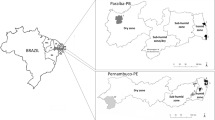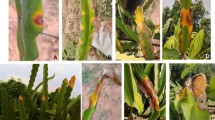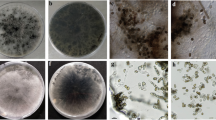Abstract
Lasiodiplodia spp. are known to cause canker, rot and dieback symptoms in several crops worldwide. In this study, two Lasiodiplodia species were identified as pathogens of native cacao accessions from the department of Amazonas, Peru, causing dieback and pod rot on young and old stems. We evaluated the macro and micro morphological characteristics, and conducted a molecular identification based on a phylogenetic analysis with a multilocus dataset with informative loci for the genus. Microscopic examination revealed the presence of immature conidia that were initially hyaline, subovoid, unicellular, and double-layered, which became reddish brown with a central septum and longitudinal grooves at maturity. In the phylogenetic analysis, we identified our isolates as L. theobromae and L. iraniensis with strong bootstrap support values. Koch's postulates were fulfilled after the re-isolation of the same species from diseased tissues of cacao fruits and stems after an artificial inoculation. Therefore, in this study, we report for the first time L. theobromae and L. iraniensis infecting native cacao plants in Amazonas, Peru.




Similar content being viewed by others
Data availability
All sequences generated in this study are publicly available under the NCBI Accession Numbers: OR428215-20, OR468298-315 (For details, see Table 2).
References
Abdollahzadeh J, Javadi A, Goltapeh EM, Zare R, Phillips AJL (2010) Phylogeny and morphology of four new species of Lasiodiplodia from Iran. Persoonia Mol Phylogeny Evol Fungi 25:1–10. https://doi.org/10.3767/003158510X524150
Adu-Acheampong R, Archer S, Leather S (2012) Resistance to dieback disease caused by Fusarium and Lasiodiplodia species in cacao (Theobroma cacao L.) genotypes. Exp Agric 48:85–98. https://doi.org/10.1017/S0014479711000883
Ali SS, Asman A, Shao J, Balidion JF, Strem MD, Puig AS, Meinhardt LW, Bailey B (2020) Genome and transcriptome analysis of the latent pathogen Lasiodiplodia theobromae, an emerging threat to the cacao industry. Genome 63:37–52. https://doi.org/10.1139/gen-2019-0112
Al-Sadi AM, Al-Wehaibi AN, Al-Shariqi RM, Al-Hammadi MS, Al-Hosni IA, Al-Mahmooli IH, Al-Ghaithi AG (2013) Population genetic analysis reveals diversity in Lasiodiplodia species infecting date palm, citrus, and mango in Oman and the UAE. Plant Dis 97:1363–1369. https://doi.org/10.1094/PDIS-03-13-0245-RE
Alves A, Phillips AJL, Henriques I, Correia A (2005) Evaluation of amplified ribosomal DNA restriction analysis as a method for the identification of Botryosphaeria species. FEMS Microbiol Lett 245:221–229. https://doi.org/10.1016/j.femsle.2005.03.005
Burgess TI, Barber PA, Mohali S, Pegg G, De Beer W, Wingfield MJ (2006) Three new Lasiodiplodia spp. from the tropics, recognized based on DNA sequence comparisons and morphology. Mycologia 98:423–435. https://doi.org/10.1080/15572536.2006.11832677
Bustamante DE, Motilal LA, Calderon MS, Mahabir A, Oliva M (2022) Genetic diversity and population structure of fine aroma cacao (Theobroma cacao L.) from north Peru revealed by single nucleotide polymorphism (SNP) markers. Front Ecol Evol. https://doi.org/10.3389/fevo.2022.895056
Carlucci A, Cibelli F, Lops F, Raimondo ML (2015) Characterization of Botryosphaeriaceae species as causal agents of trunk diseases on grapevines. Plant Dis 99:1678–1688. https://doi.org/10.1094/PDIS-03-15-0286-RE
Coutinho IBL, Freire FCO, Lima CS, Lima JS, Gonçalves FJT, Machado AR, Silva AMS, Cardoso JE (2017) Diversity of genus Lasiodiplodia associated with perennial tropical fruit plants in northeastern Brazil. Plant Pathol 66:90–104. https://doi.org/10.1111/ppa.12565
Díaz-Valderrama JR, Leiva-Espinoza ST, Catherine Aime M (2020) The history of cacao and its diseases in the Americas. Phytopathology 110:1604–1619. https://doi.org/10.1094/PHYTO-05-20-0178-RVW
Edgar R (2004) MUSCLE: Multiple sequence alignment with high accuracy and high throughput. Nucleic Acids Res 32:1792–1797. https://doi.org/10.1093/nar/gkh340
Gnanesh BN, Arunakumar GS, Tejaswi A, Supriya M, Manojkumar HB, Devi SS (2022) Characterization and pathogenicity of Lasiodiplodia theobromae causing black root rot and identification of novel sources of resistance in mulberry collections. Plant Pathol J (Faisalabad) 38:272–286. https://doi.org/10.5423/PPJ.OA.01.2022.0005
Gouy M, Guindon S, Gascuel O (2010) SeaView version 4: a multiplatform graphical user interface for sequence alignment and phylogenetic tree building. Mol Biol Evol 27:221–224. https://doi.org/10.1093/molbev/msp259
Gunamalai L, Duanis-Assaf D, Sharir T, Maurer D, Feygenberg, Sela N, Alkan N (2023) Comparative characterization of virulent and less-virulent Lasiodiplodia theobromae isolates. Mol Plant-Microbe Interact 36:502–515. https://doi.org/10.1094/MPMI-11-22-0234-R
Huamán-Pilco AF, Ramos-Carrasco TA, Franco MEE, Tineo-Flores D, Estrada-Cañari R, Romero PE, Aguilar-Rafael V, Ramírez- Orrego LA, Tincopa-Marca R, Márquez FR, Oliva-cruz M, Díaz-Valderrama JR (2023) Morphological, phylogenetic, and genomic evidence reveals the causal agent of thread blight disease of cacao in Peru is a new species of Marasmius in the section Neosessiles, Marasmius infestans sp. nov. F1000Res 12:1327. https://doi.org/10.12688/f1000research.140405.2
Huda-Shakirah AR, Mohamed Nor NMI, Zakaria L, Leong YH, Mohd MH (2022) Lasiodiplodia theobromae as a causal pathogen of leaf blight, stem canker, and pod rot of Theobroma cacao in Malaysia. Sci Rep. https://doi.org/10.1038/s41598-022-13057-9
Ismail AM, Cirvilleri G, Polizzi G, Crous PW, Groenewald JZ, Lombard L (2012) Lasiodiplodia species associated with dieback disease of mango (Mangifera indica) in Egypt. Australas Plant Pathol 41:649–660. https://doi.org/10.1007/s13313-012-0163-1
Kumar S, Stecher G, Li M, Knyaz C, Tamura K (2018) MEGA X: molecular evolutionary genetics analysis across computing platforms. Mol Biol Evol 35:1547–1549. https://doi.org/10.1093/molbev/msy096
Li GQ, Arnold RJ, Liu FF, Li JQ, Chen SF (2015) Identification and Pathogenicity of Lasiodiplodia Species from Eucalyptus urophylla × grandis, Polyscias balfouriana and Bougainvillea spectabilis in Southern China. J Phytopathol 163:956–967. https://doi.org/10.1111/jph.12398
Machado AR, Pinho DB, Pereira OL (2014) Phylogeny, identification and pathogenicity of the Botryosphaeriaceae associated with collar and root rot of the biofuel plant Jatropha curcas in Brazil, with a description of new species of Lasiodiplodia. Fungal Divers 67:231–247. https://doi.org/10.1007/s13225-013-0274-1
Marques MW, Lima NB, De Morais MA, Barbosa MAG, Souza BO, Michereff SJ, Phillips AJL, Câmara MPS (2013) Species of Lasiodiplodia associated with mango in Brazil. Fungal Divers 61:181–193. https://doi.org/10.1007/s13225-013-0231-z
Mbenoun M, MomoZeutsa EH, Samuels G, NsougaAmougou F, Nyasse S (2008) Dieback due to Lasiodiplodia theobromae, a new constraint to cocoa production in Cameroon. Plant Pathol 57:381. https://doi.org/10.1111/j.1365-3059.2007.01755.x
Miller MA, Pfeiffer W, Schwartz T (2010) Creating the CIPRES Science Gateway for inference of large phylogenetic trees. In: 2010 Gateway Computing Environments Workshop (GCE). IEEE, New Orleans, pp 1–8
Mohali S, Burgess TI, Wingfield MJ (2005) Diversity and host association of the tropical tree endophyte Lasiodiplodia theobromae revealed using simple sequence repeat markers. For Pathol 36:385–396
Moreira-Morrillo AA, Cedeño-Moreira ÁV, Canchignia-Martínez F, Garcés-Fiallos FR (2021) Lasiodiplodia theobromae (Pat.) Griffon & Maubl [(syn.) Botryodiplodia theobromae Pat] in the cocoa crop: Symptoms, biological cycle, and strategies management. Sci Agropecu 12:653–662
Motamayor JC, Risterucci AM, Lopez PA, Ortiz CF, Moreno A, Lanaud C (2002) Cacao domestication I: the origin of the cacao cultivated by the Mayas. Heredity 89:380–386. https://doi.org/10.1038/sj.hdy.6800156
Netto MSB, Assunção IP, Lima GSA, Marques MW, Lima WG, Monteiro JHA, Balbino VQ, Micherreff SJ, Phillips AJL, Câmara MPS (2014) Species of Lasiodiplodia associated with papaya stem-end rot in Brazil. Fungal Divers 67:127–141. https://doi.org/10.1007/s13225-014-0279-4
Netto MSB, Lima WG, Correia KC, da Silva CFB, Thon M, Martins RB, Miller RNG, Michereff SJ, Câmara MPS (2017) Analysis of phylogeny, distribution, and pathogenicity of Botryosphaeriaceae species associated with gummosis of Anacardium in Brazil, with a new species of Lasiodiplodia. Fungal Biol 121:437–451. https://doi.org/10.1016/j.funbio.2016.07.006
Oliva M, Rubio K, Epquin M, Marlo G, Leiva S (2020) Cadmium uptake in native cacao trees in agricultural lands of Bagua, Peru. Agron J. https://doi.org/10.3390/agronomy10101551
Oliva-Cruz M, Goñas M, García LM, Rabanal-Oyarse R, Alvarado-Chuqui C, Escobedo-Ocampo P, Maicelo-Quintana JL (2021) Phenotypic characterization of fine-aroma cocoa from northeastern Peru. Int J Agron 2021:1–12. https://doi.org/10.1155/2021/2909909
Oliva-Cruz M, Goñas M, Bobadilla LG, Rubio KB, Escobedo-Ocampo P, GarcíaRosero LM, Rojas Briceño NB, Maicelo-Quintana JL (2022) Genetic groups of fine-aroma native cacao based on morphological and sensory descriptors in northeast Peru. Front Plant Sci 13:1–11. https://doi.org/10.3389/fpls.2022.896332
Osorio-Guarín JA, Berdugo-Cely J, Coronado RA, Zapata YP, Quintero C, Gallego-Sánchez G, Yockteng R (2017) Colombia a source of cacao genetic diversity as revealed by the population structure analysis of germplasm bank of Theobroma cacao L. Front Plant Sci. https://doi.org/10.3389/fpls.2017.01994
Pavlic D, Slippers B, Coutinho TA, Gryzenhout M, Wingfield MJ (2004) Lasiodiplodia gonubiensis sp. nov., a new Botryosphaeria anamorph from native Syzygium cordatum in South Africa. Stud Mycol 50:313–322
Pereira AL, Silva GS, Ribeiro VQ (2006) Caracterização fisiológica, cultural e patogênica de diferentes isolados de Lasiodiplodia theobromae. Fitopatol Bras 31:572–578. https://doi.org/10.1590/S0100-41582006000600006
Phillips AJL, Alves A, Pennycook SR, Johnston PR, Ramaley A, Akulov A, Crous PW (2008) Resolving the phylogenetic and taxonomic status of dark-spored teleomorph genera in the Botryosphaeriaceae. Persoonia Mol Phylogeny Evol Fungi 21:29–55. https://doi.org/10.3767/003158508X340742
Phillips AJL, Alves A, Abdollahzadeh J, Slippers B, Wingfield MJ, Groenewald JZ, Crous PW (2013) The Botryosphaeriaceae: genera and species known from culture. Stud Mycol 76:51–167. https://doi.org/10.3114/sim0021
Phillips AJL, Hyde KD, Alves A, Liu JK (2019) Families in Botryosphaeriales: a phylogenetic, morphological and evolutionary perspective. Fungal Divers 94:1–22. https://doi.org/10.1007/s13225-018-0416-6
Picos-Muñoz PA, García-Estrada RS, León-Félix J, Sañudo-Barajas A, Allende-Molar R (2014) Lasiodiplodia theobromae en cultivos agrícolas de méxico: taxonomía, hospedantes, diversidad y control. Rev Mex Fitopat 33:54–74
Pisco-Ortiz C, Rodríguez E, Dávila-Mora L, Gelvez AV, Zuluaga P (2024) First report of Lasiodiplodia theobromae causing dieback on theobroma cacao in Colombia. New Dis Rep 49(2). https://doi.org/10.1002/ndr2.12266
Puig AS, Keith LM, Matsumoto TK, Gutierrez OA, Marelli JP (2021) Virulence tests of Neofusicoccum parvum, Lasiodiplodia theobromae, and Phytophthora palmivora on Theobroma cacao. Eur J Plant Pathol 159:851–862. https://doi.org/10.1007/s10658-021-02210-1
Rahim A, Shakirah H, Mohd N, Mohamed I, Zakaria L (2022) Lasiodiplodia theobromae as a causal pathogen of leaf blight, stem canker, and pod rot of Theobroma cacao in Malaysia. Sci Rep. https://doi.org/10.1038/s41598-022-13057-9
Rambaut A (2018) FigTree v1. 3.1: tree figure drawing tool. http://tree.bio.ed.ac.uk/software/figtree
Ramos DO, Rosado AWC, de Souza AF, de SouzPio A, Pereira OL (2023) Lasiodiplodia iranensis is the causal agent of Coffea canephora dieback in Brazil. Crop Prot. https://doi.org/10.1016/j.cropro.2023.106318
Rodríguez-Gálvez E, Guerrero P, Barradas C, Crous PW, Alves A (2017) Phylogeny and pathogenicity of Lasiodiplodia species associated with dieback of mango in Peru. Fungal Biol 121:452–465. https://doi.org/10.1016/j.funbio.2016.06.004
Sakalidis ML, Ray JD, Lanoiselet V, Hardy GESJ, Burgess TI (2011) Pathogenic Botryosphaeriaceae associated with Mangifera indica in the Kimberley Region of Western Australia. Eur J Plant Pathol 130:379–391. https://doi.org/10.1007/s10658-011-9760-z
Salvatore MM, Andolfi A, Nicoletti R (2020) The thin line between pathogenicity and endophytism: The case of Lasiodiplodia theobromae. Agriculture 10:1–22. https://doi.org/10.3390/agriculture10100488
Slippers B, Roux J, Wingfield MJ, van der Walt FJJ, Jami F, Mehl JWM, Marais GJ (2014) Confronting the constraints of morphological taxonomy in the Botryosphaeriales. Persoonia Mol Phylogeny Evol Fungi 33:155–168. https://doi.org/10.3767/003158514X684780
Thomas E, van Zonneveld M, Loo J, Hodgkin T, Galluzzi G, van Etten J (2012) Present spatial diversity patterns of Theobroma cacao L. in the neotropics reflect genetic differentiation in pleistocene refugia followed by human-influenced dispersal. PLoS ONE 7:1. https://doi.org/10.1371/journal.pone.0047676
Vásquez-López A, Mora-Aguilera JA, Cárdenas-Soriano E, Téliz-Ortiz D (2008) Etiología e histopatología de la muerte descendente de árboles de mamey (Pouteria sapota (Jacq.) HE Moore y Stearn) en el estado de Guerrero, México. Agrociencia 43:717–728
Zheng Q, Ozbudak E, Liu G, Hosmani PS, Saha S, Flores-Gonzales M, Mueller LA, Rodrigues-Stuart K, Dewdney MM, Lin Y, Zhang J, Tarazona YC, Liu B, Oliva R, Ritenour MA, Cano LM (2021) Draft genome sequence resource of the citrus stem-end rot fungal pathogen Lasiodiplodia theobromae CITRA15. Phytopathology 111:761–764. https://doi.org/10.1094/PHYTO-08-20-0349-A
Acknowledgements
We thank Mr. Marco Pasapera for field support during collections, and the entire staff of the Plant Health Laboratory of UNTRM-A for help during lab activities.
Funding
This study was funded by CEINCACAO (CUI N°2315081) project and by PROCIENCIA-CONCYTEC, Peru, under contract Nº PE501078997-2022-PROCIENCIA.
Author information
Authors and Affiliations
Contributions
JHP collected samples, led the conduction of all experiments, analyzed the data, and wrote the original draft of the manuscript, EHD and AFHP collected samples, conducted pathogenicity tests, and revised and edited versions of the manuscript; SMOC secured funds for the development of this study, and revised early versions of the manuscript; JRDV secured funds for the development of this study, supervised the study, analyzed the data, revised and proof-read the manuscript.
Corresponding author
Ethics declarations
Conflict of interest
On behalf of all authors, the corresponding author states that there is no conflict of interest.
Consent to participate
This study does not involve human subjects, so consent to participate was not necessary.
Human and animal rights
None of the authors conducted experiments involving human participants or experimental animals.
Additional information
Publisher's Note
Springer Nature remains neutral with regard to jurisdictional claims in published maps and institutional affiliations.
Supplementary Information
Below is the link to the electronic supplementary material.
Rights and permissions
Springer Nature or its licensor (e.g. a society or other partner) holds exclusive rights to this article under a publishing agreement with the author(s) or other rightsholder(s); author self-archiving of the accepted manuscript version of this article is solely governed by the terms of such publishing agreement and applicable law.
About this article
Cite this article
Huaman-Pilco, J., Huaman-Pilco, Á.F., Hernández-Diaz, E. et al. Dieback and pod rot caused by Lasiodiplodia theobromae and L. iraniensis in native accessions of cacao (Theobroma cacao) from Amazonas, Peru. Indian Phytopathology (2024). https://doi.org/10.1007/s42360-024-00771-9
Received:
Revised:
Accepted:
Published:
DOI: https://doi.org/10.1007/s42360-024-00771-9




